How Image Processing Revolutionizes Data Science (Day -2)
 Shahi Shreshth
Shahi Shreshth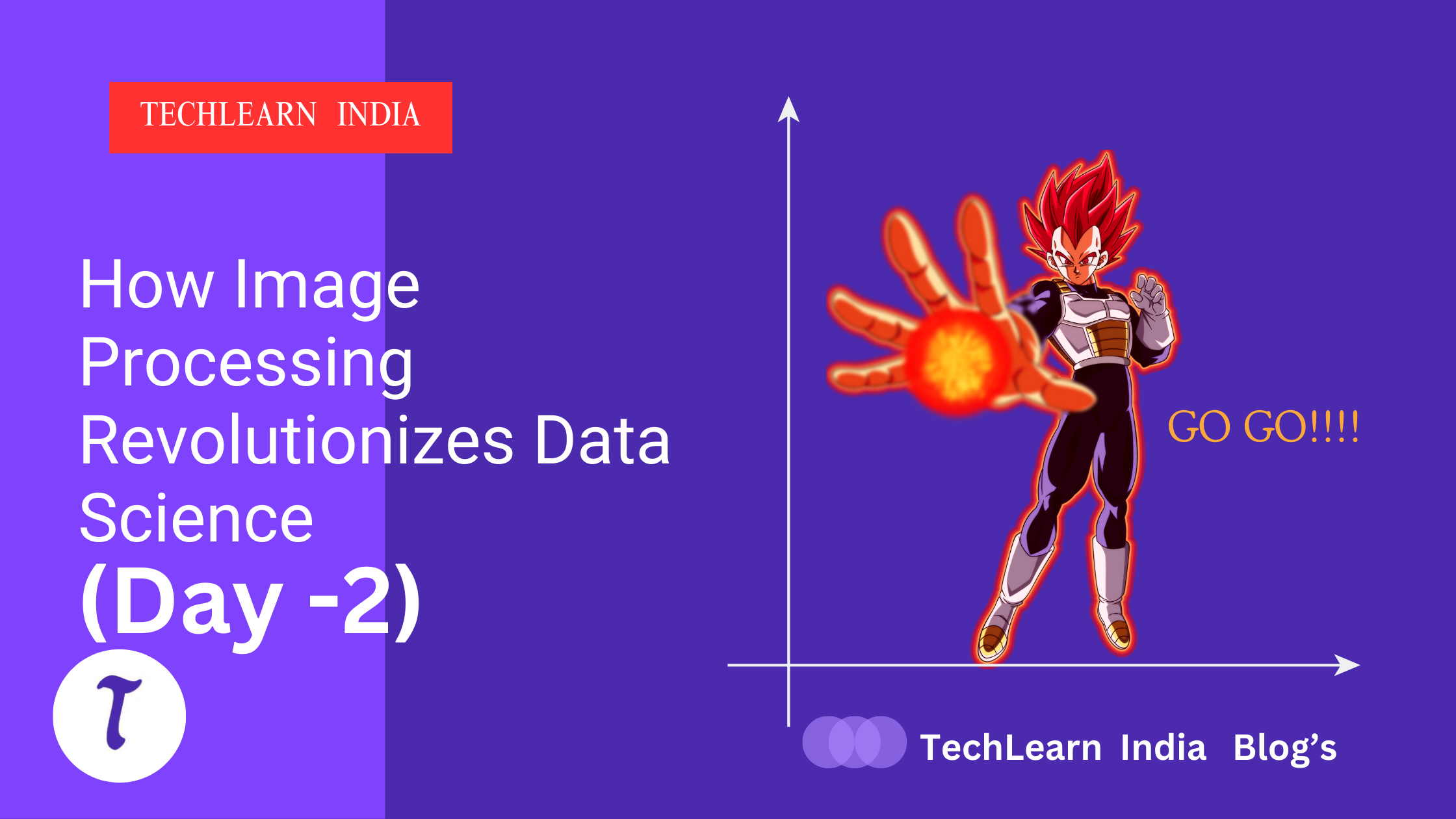
#Day 2:Creation of Shape and Create Text with Vegeta from DragonBallZ!
Ready for a power-up worthy of Vegeta himself? Today, we're leveling up our image processing skills by creating awesome shapes and text directly on images!
Prerequisites:
Libraries:
Use pip (the Python package installer) to install the following libraries:
pip install pillow matplotlib imageio opencv-python These libraries provide powerful tools for various image processing tasks:
Pillow (PIL Fork): For basic image loading, manipulating pixels, and saving results.
matplotlib: For visualizing images using plots and figures.
imageio: For handling diverse image formats and advanced loading/saving options.
OpenCV (Open Source Computer Vision Library): A comprehensive library for real-time computer vision, offering extensive image processing and manipulation capabilities.
Work Environment is Kaggle you can visit and explore it open source and free!!!!!!
Key Concepts
Calling All Saiyan Warriors!
- Drawing Circles of Energy: Harness the power of OpenCV to draw vibrant circles on images. Explore different colors, thicknesses, and even fill them with energy!
import cv2 as cv
import matplotlib.pyplot as plt
img = cv.imread('../input/vegeta/mpmdbz-02_a10.jpg',1)
img1=cv.cvtColor(img,cv.COLOR_BGR2RGB)
img2=cv.cvtColor(img,cv.COLOR_BGR2RGB)
cv.circle(img1,(200,550),150,(0,220,0),50)
cv.circle(img2,(300,850),150,(255,220,0),-5)
plt.imshow(img1)
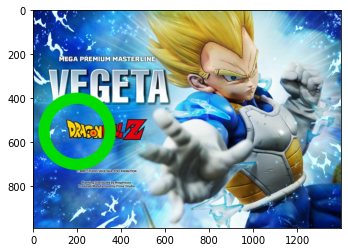
Converts both from OpenCV's default BGR (Blue-Green-Red) color space to RGB (Red-Green-Blue), a more common format for visualization.
Draws circles on the two copies:
img1: Circle at coordinates (200, 550), radius 150, color (0, 220, 0) (greenish-blue), thickness 50.img2: Circle at (300, 850), radius 150, color (255, 220, 0) (yellowish), thickness -5 (filled circle).
- Writing Messages in the Stars: ✨ Use text superimposition to add epic captions, annotations, or even recreate those iconic Dragon Ball Z battle cries!
import cv2 as cv
import matplotlib.pyplot as plt
img = cv.imread('../input/vegeta/mpmdbz-02_a10.jpg',1)
img1=cv.cvtColor(img,cv.COLOR_BGR2RGB)
font = cv.FONT_HERSHEY_SIMPLEX #font family
cv.putText(img1,'Go! Go!',(500,500),font,5,(200,10,100),30) #
plt.imshow(img1)
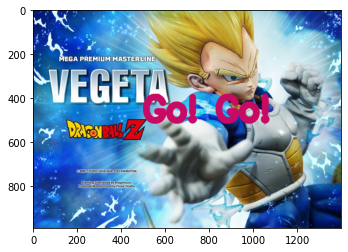
Sets the font to be used for text.
cv.FONT_HERSHEY_SIMPLEXis a simple.Draws the text "Go! Go!" on the modified image
img1.Arguments:
img1: The image to place the text on.'Go! Go!': The text to write.(500, 500): The coordinates for the bottom-left corner of the text.font: The font selected earlier.5: Font scale (size).(200, 10, 100): Text color in BGR format (pinkish-purple).30: Thickness of the text lines.
- Pixel Perfect Precision: Master accessing and manipulating individual pixels to create custom effects or highlight specific areas of interest.
import cv2 as cv
import matplotlib.pyplot as plt
img = cv.imread('../input/vegeta/wp4534369.jpg',1)
img1 =cv.cvtColor(img,cv.COLOR_BGR2RGB)
font = cv.FONT_HERSHEY_SIMPLEX
cv.putText(img1,'Go! Go!',(500,200),font,5,(200,10,100),30)
plt.imshow(img1)
cv.cvtColor(img,cv.COLOR_BGR2RGB)
cv.rectangle(img1,(0,0),(250,200),(0,0,250),-9)
cv.cvtColor(img,cv.COLOR_BGR2RGB)
cv.rectangle(img1,(1000,800),(1300,1080),(0,250,0),-9)
cv.cvtColor(img,cv.COLOR_BGR2RGB)
cv.circle(img1,(1160,650),150,(220,0,0),50)
cv.cvtColor(img,cv.COLOR_BGR2RGB)
cv.line(img1,(750,1000),(980,830),(250,250,10),80)
cv.cvtColor(img,cv.COLOR_BGR2RGB)
cv.line(img1,(1290,830),(1500,1000),(250,250,10),80)
plt.imshow(img1)
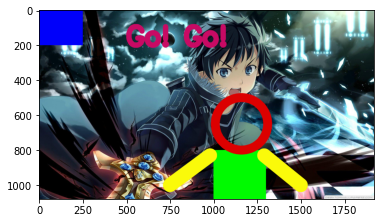
Draws two filled rectangles:
One in the top-left corner (blue), 250x200 pixels.
One in the bottom-right corner (green), 300x280 pixels.
Draws a red circle with a radius of 150 pixels, centered at (1160, 650).
Draws two thick, yellow lines:
One starting at (750, 1000) and ending at (980, 830).
One starting at (1290, 830) and ending at (1500, 1000).
Challenges for the Worthy:
Experiment with different shapes: Draw rectangles, lines, or even custom shapes using OpenCV's drawing functions.
Combine shapes and text: Create dynamic image compositions that tell a story or highlight key features.
Apply shape-based techniques: Try out image segmentation, object detection, or creative image manipulation using shapes as tools.
Over 9000 Possibilities!
Whether you're analyzing Vegeta's power levels or creating your own manga-inspired art, the possibilities are limitless!
Stay tuned for Day 3, where we'll explore even more exciting image processing techniques! ⚡️
P.S. Don't forget to share your image creations and any questions in the comments below! Let's build a thriving Saiyan community of image processing enthusiasts!
#ImageProcessing #DataScience #DragonBallZ #Vegeta #OpenCV #Shapes #Text #Day2
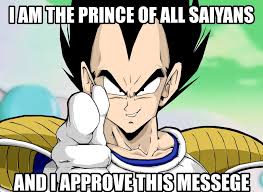
Subscribe to my newsletter
Read articles from Shahi Shreshth directly inside your inbox. Subscribe to the newsletter, and don't miss out.
Written by
